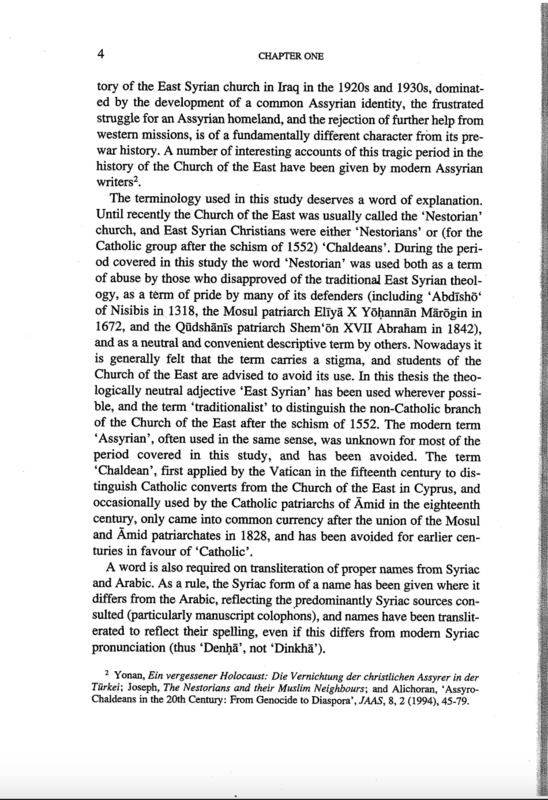-
Title
-
The Ecclesiastical Organisation of the Church of the East, 1318-1913
-
Creator
-
David Wilmshurst
-
Date
-
2000
-
Description
-
Wilmshurst opens by noting that the 1920s–1930s saw the rise of a common Assyrian identity, a struggle for an Assyrian homeland, and a turn away from Western missions—developments that mark a fundamentally new phase compared with the prewar history of the Church of the East. He then explains his terminology policy. For most of the period he studies (1318–1913), the church was commonly called “Nestorian” and its faithful were “Nestorians” (or “Chaldeans” for those who entered communion with Rome after 1552). In the sources of the time, “Nestorian” could be a term of abuse used by opponents of East Syrian theology, a badge of pride among its own defenders, and a neutral descriptor in other contexts. He gives concrete examples of East Syrian leaders who used the term positively: ‘Abdisho‘ of Nisibis (1318), Patriarch Eliya X of Mosul (1672), and Patriarch Shem‘un XVII Abraham (1842). Because the word has acquired a stigma in modern discussion, Wilmshurst avoids it as a label in his own prose and instead uses the theologically neutral “East Syrian.” To distinguish the post-1552 non-Catholic branch he uses “traditionalist.”
Wilmshurst also clarifies two other labels that appear in modern writing. First, the modern ethnonym “Assyrian”—often used today in roughly the same sense as “East Syrian” for the non-Catholic branch—was not in use for most of the period he covers, so he avoids it for historical accuracy. Second, “Chaldean,” which the Vatican first applied in the 15th century to identify Catholic converts from the Church of the East in Cyprus, and which was occasionally used by the Catholic patriarchs of Amid in the 18th century, only entered common currency after 1828 with the union of the Mosul and Amid patriarchates; for earlier centuries he therefore prefers “Catholic.” He adds a short note on transliteration: where Syriac and Arabic forms differ, he gives the Syriac form (reflecting his Syriac sources, especially manuscript colophons) and standardizes spellings accordingly—e.g., Denha, not Dinkha.
-
Language
-
English
-
Publisher
-
The Ecclesiastical Organisation of the Church of the East, 1318-1913, David Wilmshurst, 2000, p. 4.
-
Subject
-
Christianity


